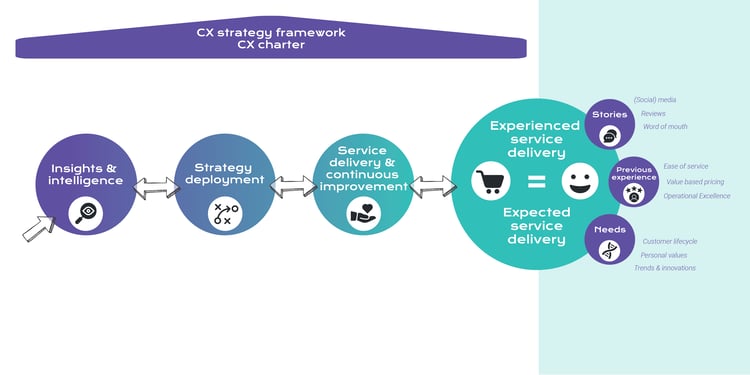|
Chapter navigation |
I strongly believe that an outstanding customer experience has become a key differentiator in all industries. 67% of consumers cite bad experiences as a reason to churn.
Organisations all strive for happy customers and try to offer a flawless and wonderful customer experience… but looking at the stats, we can only conclude it often goes wrong. Customer Satisfaction Scores (CSAT) and Net Promotor Scores (NPS) vary by industry but clearly show that organisations that succeed in constant amazement are still a minority. Aren’t we all familiar with the following mistakes: misleading customers, asking for the same information repeatedly, mismatch between online and offline channels?
What is customer satisfaction?
Before taking measures to improve customer experience and increase satisfaction, we must understand what customer satisfaction truly means. When are customers happy? Difficult to say, after all, we are talking about a feeling, an emotion. But, the best definition of satisfaction I have heard and used so far is the following.
As a customer, you are happy when your expectations are met or exceeded. Hence, when experiences match expectations.

Fair enough, sounds like a simple equation. But put in practice, this entails huge challenges for most organisations. Let me take you through the different challenges.
Challenge 1: What do customers expect?
How are expectations formed? How are they evolving? How diverse are they per market, segment, and customer? And to what extent can you influence expectations? This first challenge is also referred to as the knowledge gap: do organisations truly understand customer expectations, perceptions, and behaviour?
Customer expectations are mainly based on:
- stories about your brand
- previous experiences with your brand or competition
- own needs, values, and points in life
This means that as an organisation you can impact customer expectations and perceptions via your upfront communication up and your actual actions or delivered experiences. Which stories do you tell? Which experiences do you offer?
Challenge 2: What is a good customer experience?
Once you have a good view of what your customer base expects from your brand, you have to define a good experience. So, your second challenge is to translate customer needs into correct product and service specifications. In this process, you will develop a clear customer strategy with a unique value proposition and use service design methods and tools such as customer journey mapping, personas, and service blueprints … to shape the ideal experience. Failure at this stage leads to the so-called specification or design gap.
Challenge 3: Deliver what you promise!
The third challenge regards the actual implementation. It is one thing to have a great vision, strategy, nice products and clear service promises. It is another to deliver good experiences daily. This challenge entails managing operations and fostering a customer-centric mindset among employees. Operational Excellence and change management skills are key to reducing the implementation gap. To reduce this last though important gap, we firmly believe that CX and OPEX (Operational Excellence) go hand in hand.
Mind the gaps!
How well are you doing? Companies that invest in great experiences win in loyalty and make a difference. These companies generally keep track of their efforts by collecting customer insights to take action and make impactful changes. They use CX metrics such as CSAT (Customer Satisfaction), NPS (Net Promotor Score) and CES (Customer Effort Score).
Source: Forrester
We believe that in addition to these metrics, you should keep track of your operational performance per service and product line via smart dashboards and assess the different gaps.
-
Knowledge gap: do I still fully understand customer needs? Think of unresolved issues and employees who do not understand customer needs.
-
Design gap: is my offer still the correct answer? Suboptimal customer channels, too much automation, lack of human touch, unpersonal experiences
-
Implementation gap: how well are we doing to deliver this today? Think of missed customer calls, long waiting times, asking the same over and over again, and rude or impolite employees.
![CX model_gaps_no tools[61]](https://blog.mobius.eu/hs-fs/hubfs/CX%20model_gaps_no%20tools%5B61%5D.png?width=750&height=375&name=CX%20model_gaps_no%20tools%5B61%5D.png)
To monitor and reduce these different gaps, you can use a set of methods and tools.
Minimise the Knowledge Gap with
-
Customer research: surveys, focus groups, observations, interviews …
-
Data analytics on customer touchpoints and interactions
Minimize the Design Gap with
-
Persona & Customer Journey Mapping
-
Process audits
-
Service Blueprints
-
Define KPI’s, SLA’s and KBI’s
Minimize the Implementation Gap with
-
Smart dashboards combining customer metrics and operational performance metrics
-
Hire, coach and train on CX skills
-
Use customer feedback in the organisation to drive change
-
Recognize and reward customer-centric behaviour
-
Manage employee experience (a key driver of customer experience)
-
And many more
![CX model_no offering[57]](https://blog.mobius.eu/hs-fs/hubfs/CX%20model_no%20offering%5B57%5D.png?width=750&height=375&name=CX%20model_no%20offering%5B57%5D.png)
So, in conclusion:
-
Know what your customers need at each moment in the customer lifecycle. Why do they choose your brand and what do they expect from you?
-
Get your story straight. Communicate what you stand for and clearly state your service promises.
-
Deliver what you promise. Manage the actual delivery of experiences in your day-to-day operations.
-
Focus on culture. Do not manage CSAT or NPS but manage a customer-centric culture.
Are you anxious to start shaping wonderful experiences? Start today! And bear in mind. It is all about EXPERIENCE. Customers do not always remember what you claimed or said as a brand … but they will remember how you made them feel.
We are happy to help!
As CX consultants we guide organisations on their journey to improve customer experiences by setting up a transversal CX program to:
-
Understand customer needs and expectations
-
Define a clear CX strategy
-
Develop a roadmap to reduce the gaps
-
Implement concrete projects in the day-to-day operations with a positive impact on CX
-
Foster a CX culture, and mindset among all teams
![CX model_all[54]](https://blog.mobius.eu/hs-fs/hubfs/CX%20model_all%5B54%5D.png?width=750&height=375&name=CX%20model_all%5B54%5D.png)








/Mini-guide%20Employee%20Experience/MiniGuide_EmployeeExperience_uitgelicht.png?width=410&height=220&name=MiniGuide_EmployeeExperience_uitgelicht.png)





.png?width=410&height=220&name=employer-experience-zorg-sector-unie-k%20(1).png)